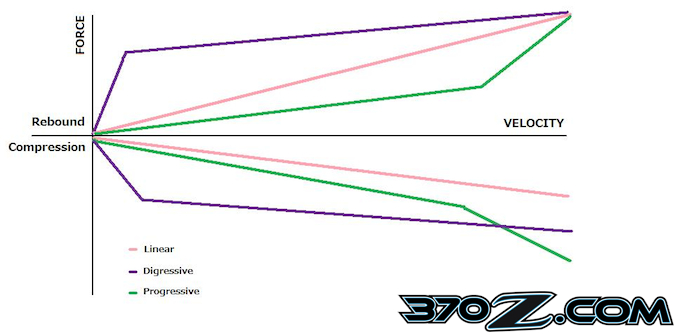MotoIQ Staff posted on January 02, 2009 21:03

The 370Z's driving dynamics are most impressive. The first thing you notice is the stiff chassis vault-like stiffness. This stiffness gives a solid confidence inspiring feel to the steering response and is a major player in the 370Z's smooth comfortable ride. Now the 350Z was no slouch in the chassis stiffness department but the 370Z sets new ground in this attribute, the car feeling like it was carved out of a chunk of steel billet. Amazingly, the Z is perhaps the smoothest riding high performance sports cars that we have ever driven. The stiff chassis is a big player in this and the Nissan “quick response” shocks no doubt help.
We think that the quick response shocks have a highly digressive damping curve. This means that the shocks have a lot of damping force in both compression and rebound in the 0-2.5 inch per second shaft movement velocity range. These low shock movement speeds correspond to gross body movements like cornering roll, brake dive and acceleration squat. Lots of damping here helps control that cornering roll, brake dive and squat as well as speeding transient response. This gives the car a crisp, fast reflex feel as opposed to a boat-like Buick ride.
Shock shaft velocities that give a floating queasy feeling are in the 2.5 inch to 5 inch per second range. Bumps and chuck holes correspond to shock shaft velocities of about 5 inches per second and higher. Digressive valving has a lot of force in the low speed range and reasonable damping force in the mid speed range but blow off and allow free wheel movement at higher shaft speeds. This gives a shock the ability to work well in diametrically opposite directions, good body motion control, crisp control feel and good ride.
 |
| The chart shows different shock damping curves, progressive damping gives more damping force, the faster the piston velocity is. This sort of curve is used for off road vehicles or sometimes a rough dirt track set up where resistance to bottoming is important. A linear curve has the damping force build up gradually as the shock piston velocity increase. This is the way most shocks were valved until recently. A digressive curve like that found on the 370Z's shocks gives a lot of resistance to movement at low piston velocities, thifs helps control body roll and pitch better. At high velocities, the valving blows open and allows the wheels to move absorbing the shock of big bumps. When calibrated correctly, Digressive valving gives the best of both worlds, good handling and smooth ride. |
The 370Z's NVH (engineers slang for noise vibration and harshness) or the lack thereof is the next thing to strike the driver. Even this preproduction 370Z in an almost eerie way had absolutely no squeaks or rattles, something else we have yet to experience on a sports car. On our short drive we didn't experience much in the way of any irritating characteristics, almost as if Nissan has created the Toyota Camry of sports cars!
On to the fun parts, driving fast like the car was designed for. Although we didn't get to wring the car out at the absolute limit on the track like we would like to, we did get to drive the car hard enough on our short test drive to form some opinions of it. At speed, the car's balance is similar to the 350Z, close to neutral with light understeer as the terminal cornering characteristic. At lower speeds that tail can be coaxed outward with throttle and with lift throttle and or a little trial braking at higher speeds making the 370Z a pretty easy and safe car to drive at the limit. The cars viscous limited slip differential worked smoothly with the car able to put the power down on corner exit a little better than a 350Z, probably due to the 370Z's diff teaming with the more supple suspension with less anti-squat geometry. The 370Z's limit handling is much better than the 350Z in two areas; in steering feel and precision and the amount of front grip. The 370 has more front grip and will hang in longer before understeer starts to build up at the limit. The 370Z's steering feels sharp and precise, while the 350Z's feels rubbery and disconnected at the limit.
Another area of great improvement is the 370Z's VDC stability control and traction control operation. In the 350Z, the traction control was very abrupt in operation; we used to jokingly refer to it as autobog, as if the computers were over reacting to sensing wheels spin. Sometimes this would result in a dangerous situation where the car would launch out into traffic when making a turn only to have the traction control kick in and greatly slow the car right when acceleration was needed. In high speed driving situations the VDC was also annoyingly overly intrusive, kicking in harshly and turning a balanced cornering situation into terminal understeer.
In the 370Z the VDC and traction control is much more transparent in operation and not as intrusive during at-the-limit driving, more of a driver's aid than obstruction. It's as if the resolution and frequency response of the system have been improved threefold and the tuning targets have been more accurately mapped. Perhaps an experienced driver may still opt to switch the system off in a street driving situation but most drivers should probably leave it on for all but track driving and only the most experienced switch it off even then.